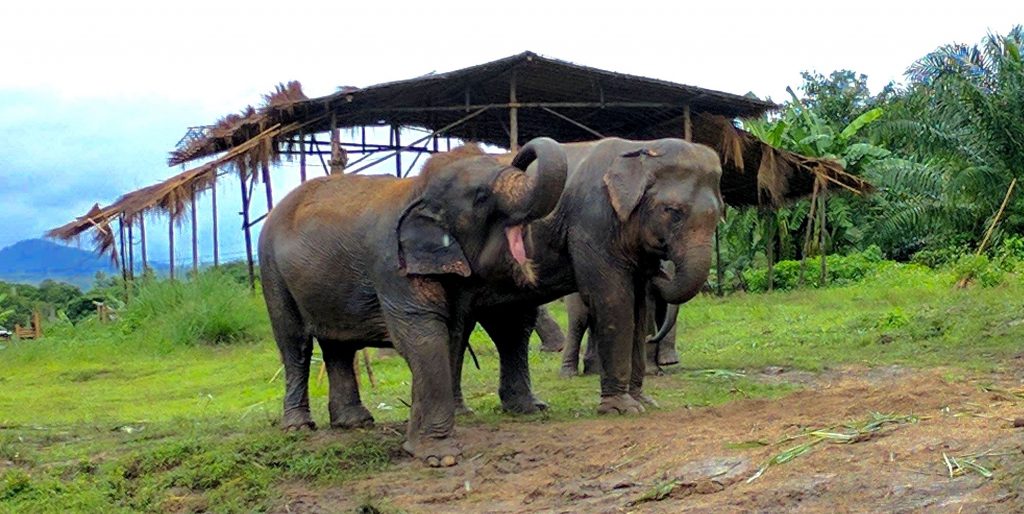A wizened, bespectacled man sells bananas by the bushel at a street stall. Across the road, several dozens of people file into a nondescript building. This is where the local government holds town meetings. Today is a special occasion, as the county sheriff has organized a day-long series of meetings, inviting the elephant veterinarians (and the vet student interning with them—yours truly) to preside on this conference. Also in attendance were owners and mahouts representing 30 different elephant camps throughout the province of Chiang Mai.
The meeting agenda was split into different sessions. The morning was dedicated to announcements from the council committee on Chiang Mai’s expectations, standards, and responsibilities bestowed upon its elephant camp owners. The afternoon session was an informative presentation by the elephant vets on EEHV (Elephant Endotheliotropic Herpesvirus). The vets educated the mahouts and owners present on what clinical signs to look for, delineated the virus’ pathological progression, and emphasized the importance of early detection of this serious disease.
After a brief tea break, the vets took the stage once more to discuss the newly formed Chiang Mai Elephant Alliance. The objectives of this organizational body were described as combating both “internal” and “external threats.” The former refers to disease and other risks to animal health, whereas the latter refers to animal rights—not to be confused with animal welfare—activist groups who propagate misinformation and tend to particularly defame mahouts.
The final session was conducted by representatives of a tunnel corporation to discuss a recently approved irrigation project. Beginning next week, they would commence an underground bombing protocol to create a tunnel that would connect two neighboring rivers. Doing so would improve water supply to Chiang Mai—a measure that the townspeople deemed necessary and beneficial.
According to the construction company, the tunnel was projected for completion in two to three years. The initial stage involved creating the actual opening. To achieve that, there would be four months of bombing, once a day, with the bombs gradually increasing in strength. All this talk of explosives conjured graphic war images, but I was assured that the bombs would be detonated at a safe depth. There were no risks of crumbling buildings, landslides, or the earth splitting open beneath us. The bomb site would be well-contained and manifest only as an audible boom and vibrations in the ground—seismic signals that elephants have been postulated to detect and communicate with.
While an enhanced irrigation system that will benefit the people is something to be celebrated, one cannot neglect the hundreds of elephants who also happen to reside in that same locale. Fortunately, that’s precisely why the town council summoned this meeting. The committee recruited prominent members of the veterinary community to weigh in on this very issue: the welfare of the elephants.
In camps located near the bombing site, the vets were tasked with monitoring the elephants at the time of explosion. Given the sensitivity of these elephants to seismic waves, the committee was concerned about the animals’ well-being during the course of this long-term irrigation project. Behaviors we had to watch out for included loud trumpeting, slamming of the trunk on the ground, and stampeding—which would endanger the mahouts and their families living on the camp site. Chronic side effects from months of bombing could potentially develop, such as elevated cortisol (stress) levels and the cessation of eating/drinking. Since this project is ongoing, we have yet to see if any serious chronic health issues materialize. From the bomb trials conducted so far, the only responses we witnessed from the elephants were brief pauses followed by the resumption of eating—nothing concerning!
I was touched that the tunnel corporation entrusted the veterinarians with such consideration and responsibility, making sure we were present at each detonation to observe the elephants’ demeanors. Stories like these stand in such contrast to the age-old tale of “Big Business” pursuing commercial developments at the expense of—and lack of regard for—wildlife and the environment. The inclusivity, thoughtfulness, and involvement of multiple parties (e.g. mahouts, camp owners, vets, council members, town residents, construction workers) reflect how the exemplary members of the Chiang Mai community assembled to address the needs of various stakeholders while still supporting elephant welfare.
This post is written by Elvina Yau and was originally published on her WordPress blog, Elvina the Explorer, on July 28, 2017.
Read Part 1 of the Elephant Diaries here.



